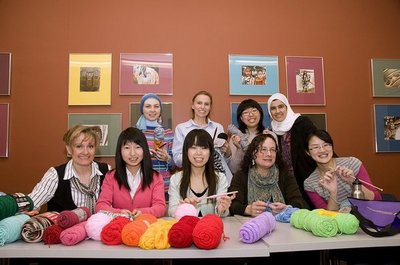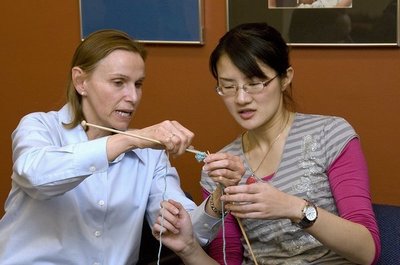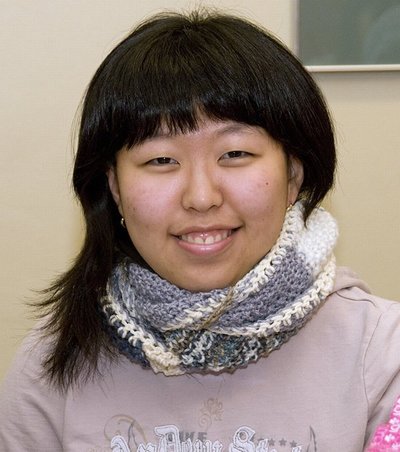April 15, 2010
Circle of Friends knitting group headed toward goal of 1,000 scarves
It all started with a death.
Kim Newcomer, extension lecturer at Educational Outreach, lost a friend and colleague five years ago, which got her contemplating those larger questions about her life. One day, not long after, she saw someone on the street asking for money.
“He was obviously hungry and cold, and I never have any change to give,” she said. “I remembered seeing a story on TV about a girl who made blankets and gave them to the homeless, and I thought, ‘What can I make and give away?'”
That’s when she thought of scarves.
“I like to make things, but I really wouldn’t call myself a knitter,” Newcomer said. “My skills are pretty basic, but a scarf is really doable with minimal skills.”
She decided on a goal of 1,000 scarves, rather like the 1,000 paper cranes that Japanese legend promises will bring the granting of a wish. But Newcomer’s only wish is that some needy people be a little warmer — and that those making the scarves learn and grow together.
That’s why she started the Circle of Friends, a weekly knitting and crocheting group that has met for eight weeks every quarter in the HUB since the winter of 2006. They complete about 200 scarves a year, all of which are given away at Christmas. Newcomer expects they’ll reach her 1,000 scarf goal by Christmas 2010.
Most of the scarf makers are students in the Intensive English Language Program offered by Educational Outreach. They are here strictly to improve their English — either to enhance their professional standing at home or to go on to an American university. That means they are in class four hours a day, and at the Circle of Friends they can socialize and make conversation in English while they knit or crochet.
Susan Park, who is from South Korea, has been an avid participant in Circle of Friends for the past year, even attending during winter quarter when she was not taking classes. “I like learning new things and I like helping people, so it’s been great to learn how to make scarves for people who need them,” said Park, who has made 50 scarves herself.
She also said her English has improved a lot through the conversations she’s had at the group, and that she has “a better understanding of people with various backgrounds.”
Two of Newcomer’s fellow lecturers — Jennifer Altman and Cherie Lenz-Hackett — have been a vital part of the project since the beginning . Altman is the organizer of the group — the one who makes the schedule, reserves the room, creates a sign-up sheet — while Lenz-Hackett has provided almost all of the yarn through bargain shopping and seeking out donations. In addition, Altman and Lenz-Hackett are prolific scarf makers, both contributing hundreds of scarves to the project.
“Those who come need not know how to knit or crochet; we’ll teach them,” Newcomer said. “And we supply all the materials.”
Most students, she said, don’t come with those skills, but the group has a motto: “Every scarf is a good scarf.”
Most of the scarves they’ve made have been donated to First Place, a school for homeless children, with the rest going to New Beginnings, a shelter for women from domestic violence situations. Children at the school get to choose two scarves each — one to keep and one to give as a gift.
Newcomer keeps records of all their products. When a scarf is completed, the scarf maker fills out a card with his/her name and home country, and a sample of the yarn. There is also a card for the scarf maker to write a message to the person who will receive the scarf. She said about 15 people a quarter participate in the project.
The group welcomes anyone who likes to knit or crochet to participate. They meet from 11:30 a.m. to 1:15 p.m. on Thursdays, from the second to the eighth week of the quarter at the HUB. Ask at the HUB Information Desk where they are meeting on any given Thursday.
Newcomer plans to disband the project when her 1,000-scarf goal is reached, because, after all, 1,000 is a lot of scarves.
“It’s something I feel proud of on different levels,” she said. “First, it’s wonderful to give something to people who tend to get lost in society. And second, it’s been great to have worked so closely with Jennifer and Cherie. Without their involvement, no way would we have made it to 1,000. Then too, just spending time with students in a different atmosphere—not a classroom — has been very satisfying.”



